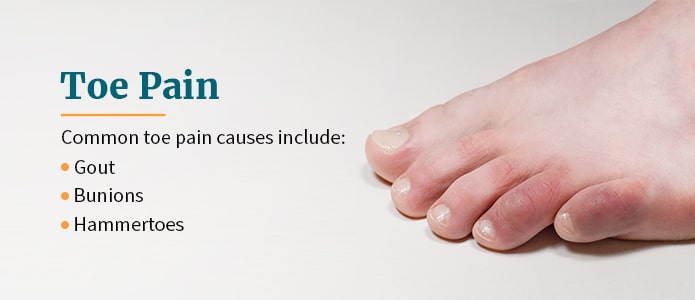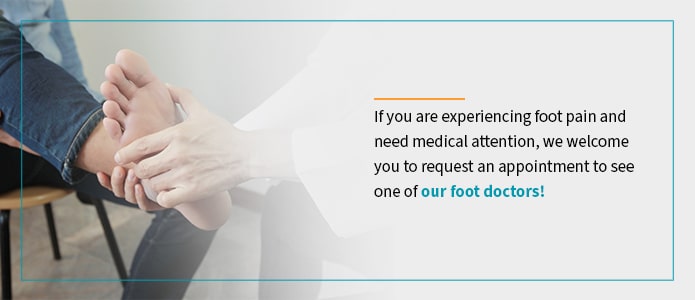-Types of Foot Pain
-Other Causes of Foot Pain
-Symptoms That Warrant Medical Attention
In many ways, your feet are your body’s unsung heroes. They support the weight of your body each day, and they take you where you want to go one step at a time.
So when you experience foot pain and other problems, it can keep you from doing the things you want to do. Here are some of the possible reasons your foot pain may be occurring, possible treatment options and when you should see a doctor.
Types of Foot Pain and Treatment Options
Foot pain can occur in different parts of the foot due to various conditions, and the location of your foot pain can inform you of the cause — anything from shoes that don’t fit correctly or trauma to the foot to chronic arthritis, diabetic neuropathy or prolonged strain on the tendons, also known as a repetitive strain injury (RSI).
The treatment options for foot pain also vary depending on foot pain cause and severity. We’ve organized some common foot pain causes and their treatment options below according to where they occur on your foot.
Heel Pain
One area of the foot that is prone to pain is the heel. Causes of heel pain include:
- Plantar fasciitis: Plantar fasciitis is an RSI that’s common among runners or people who are often on their feet. It occurs when the ligaments along the arch of your foot between your toes and heel become stretched and inflamed. To treat plantar fasciitis, your doctor will likely suggest orthotics, rest, non-steroidal anti-inflammatory drugs (NSAIDs) and physical therapy. If the pain is intense, they may offer corticosteroid injections. Surgery is rarely needed.
- Heel spurs: Heel spurs occur when excess bone tissue grows on the underside of your heel near your arch. The stress inflicted on the heel from plantar fasciitis is the most common cause. Treatment for heel spurs involves rest, custom-fitted shoes, corticosteroid injections or surgery.
- Heel fractures: Heel fractures are almost always serious injuries caused by trauma from a fall or another accident. Bruised and swollen heels that you have trouble walking on are common signs of a heel fracture. Treatment involves extended rest, splints or casts, physical therapy and surgery if the pain continues.
Other causes of heel pain could include a ruptured Achilles tendon, Achilles tendinitis, stone bruise or psoriatic arthritis.
Ball of the Foot
Common causes of pain in the ball of your foot include:
- Sesamoiditis: If the ball of your big toe causes you pain, you might have sesamoiditis. In that space are two small bones called sesamoids. When the tendons that connect those bones become inflamed from overuse, sesamoiditis occurs. To treat this RSI, your doctor will likely recommend rest, orthotics, NSAIDs, tape to immobilize the big toe and corticosteroids if you experience intense pain.
- Morton’s neuroma: High heels, small-fitting shoes, being on your feet for extended periods or all three together are common culprits of Morton’s neuroma. This condition occurs when non-cancerous tissue builds up between the metatarsal bones located beneath your ankle to the balls of your feet. This tissue pinches the nerves between those bones. Initial treatment for Morton’s neuroma involves rest and footwear changes. You may need corticosteroid injections or surgery in rare cases if symptoms persist.
- Metatarsalgia: Like Morton’s neuroma, shoes that are too small can cause metatarsalgia, or inflammation in the ball of your foot. Treatment involves over-the-counter (OTC) pain relievers, ice packs, comfortable footwear that fits and shoe inserts to relieve pressure.
Pain in the ball of your foot could also indicate a metatarsal fracture or sprain, bursitis or arthritis.

Toe Pain
Common toe pain causes include:
- Gout: This painful “disease of kings” involves build-ups of uric acid crystals in toe joints. If you have gout, you likely experience swelled, painful toes, especially your big toe. As a form of arthritis, gout treatment involves ice packs, NSAIDs, dietary changes and corticosteroids for intense pain.
- Bunions: Although bunions look like growths beside your big toe, they are actually dislocated big toe joints. Pointy-toed shoes can significantly contribute to bunion formation. As with any dislocation, bunions can cause significant pain. Bunion treatment involves comfortable shoes that fit, shoe inserts or surgery for persistent pain.
- Hammertoes: Hammertoes are related to bunions as they are dislocated toe joints in the middle toes. They cause the toes to bend at the joint with a hammer-like appearance. Ill-fitting shoes or muscle imbalances in your feet are common causes. To treat hammertoes, doctors recommend wearing broad-toed footwear and exercises to strengthen and stretch your toe muscles. If the pain does not subside, surgery is an option.
Some other reasons for toe pain may be ingrown toenails, toe fracture or corns and calluses.
Other Causes of Foot Pain
Some of the other reasons your feet can become painful include the following.
Diabetic Neuropathy
Diabetic neuropathy is nerve damage caused by type 1 or type 2 diabetes. Although you can experience diabetic neuropathy in several areas, it often manifests in your legs and feet. Symptoms include sharp pains and tingling or burning sensations occurring anywhere in your feet. Diabetic neuropathy has no cure, so treatment involves a long-term management plan. These plans aim to slow the progression, relieve pain, manage complications and restore function.
Arthritis
Arthritis is not unique to the feet, but it often shows up there. Treatment depends on the arthritis type and also involves a chronic pain management plan. Several types of arthritis can afflict the feet:
- Osteoarthritis, which is cartilage degeneration between your joints and bones.
- Rheumatoid arthritis, an autoimmune disorder where your immune system attacks your joint fluid.
- Psoriatic arthritis, which causes rashes and stiff joints.
Athlete’s Foot
Athlete’s foot is a fungal infection that usually affects the skin between your toes. However, it can spread elsewhere in advanced cases. It involves painful and itchy rashes that can blister. You might experience athlete’s foot when wearing wet or sweaty socks without changing them or going barefoot in public spaces like swimming pools. Treatment involves antifungal cream and powders, but you may need to see a foot care specialist if symptoms do not improve.
Symptoms That Warrant Medical Attention
You can experience foot pain from something as simple as standing on your feet for too long or something as serious as a fractured heel. As such, you may not know if your foot pain is serious enough to see a doctor or if it will improve with rest. To help you know if you should seek medical attention for foot pain, here are some signs that you should see your doctor about your symptoms:
- Chronic pain or swelling in your feet
- Difficulty or inability to bear weight on your feet or walk
- Frequent numbness or tingling sensations
- Infections in your feet
- Intense foot pain
- Open wounds that resist healing
- Tender and warm areas of your feet, especially if a fever is present

See an OIP Orthopedic Doctor About Your Foot Pain
Our board-certified orthopedic doctors and podiatrists at the Orthopedic Institute of Pennsylvania can accurately diagnose the source of your foot pain and provide the most effective treatment option so you can trust the support your feet give you once again. If you are experiencing foot pain and need medical attention, we welcome you to request an appointment to see one of our foot doctors!


